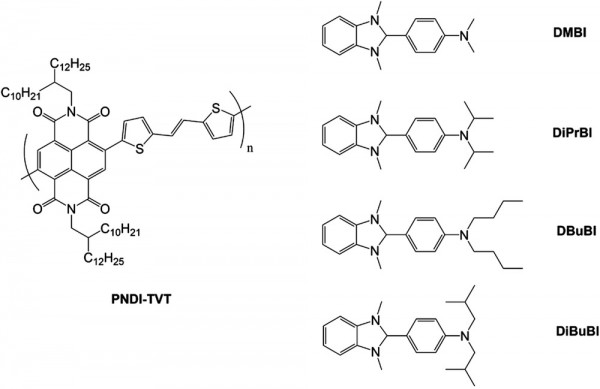Enhanced N-Type Doping of a Naphthalene Diimide Based Copolymer by Modification of the Donor Unit
- 저자
- Marco Cassinelli, Simone Cimò, Till Biskup, Xuechen Jiao, Alessandro Luzio, Christopher R. McNeill, Yong-Young Noh, Yun-Hi Kim, Chiara Bertarelli, Mario Caironi*
- 저널명
- Advanced Electronic Materials, 7, 12, 2100407 (2021)
- 년도
- 2021
- Link
- https://doi.org/10.1002/aelm.202100407 877회 연결
[Abstract]
Doped conjugated organic semiconductors are suitable materials to be used as building blocks of flexible and cost-effective thermoelectric generators. While several efficient solution-processable p-type organic thermoelectric materials are reported, n-doped materials are fewer because of lack of good electron-transporting materials and stable n-dopants. Here, n-doping process is investigated on a relevant n-type class, namely naphthalene-diimide-based copolymers. Among these, copolymer incorporating bithiophene (T2) donor units, largely studied poly{N,N″-bis(2-octyl-dodecyl)-1,4,5,8-naphthalenedicarboximide-2,6-diyl]-alt-5,5′-(2,2′-bithiophene)} (PNDI-T2), is one of first polymers reported to achieve good solution-based n-doping. By substituting T2 with thienylenevinylene-thienylene (TVT), resulting PNDI-TVT copolymer exhibits improvements on both structural and transport properties, offering a suitable basis to improve thermoelectric properties upon doping. When doped with 1H-benzimidazoles, PNDI-TVT achieves maximum in-plane electrical conductivity at room temperature of 2.4 × 10−2 S cm−1, being the highest value for PNDI-T2 solution-doped derivatives excluding those with oligoethylene-glycol chains. Electron paramagnetic resonance and variable temperature electrical conductivity measurements relate this enhancement to more efficient charge-transfer between n-dopant molecules and host polymeric matrix, and easier charge carrier transport within the system. This electrical conductivity large enhancement also improves in-plane power factor of almost three times with respect to similar doped PNDI-T2 films.
